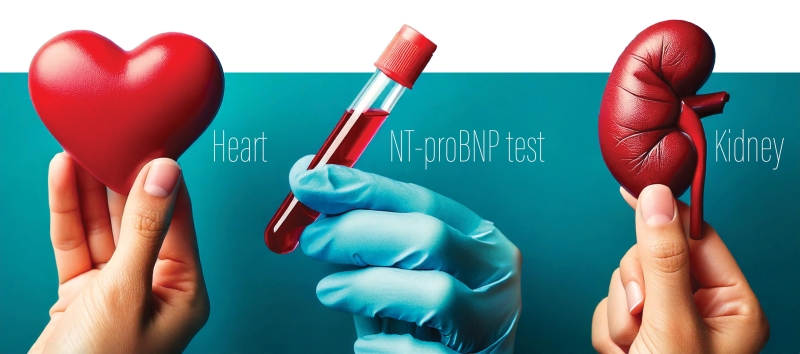NT-proBNP predicts cardiorenal complications in Chinese patients with T2D





Elevated N-terminal pro–B-type natriuretic peptide (NT-proBNP) levels independently predict cardiorenal complications in Chinese patients with type 2 diabetes (T2D) and can be utilized as a clinical prognostic biomarker for risk stratification to enable more intensive organ-protective treatment in those at risk, a study involving 1,993 patients enrolled in the Hong Kong Diabetes Biobank has shown.
Notably, the use of NT-proBNP with established clinical risk factors was found to improve prediction of incident cardiorenal complications among these patients compared with the use of clinical risk factors alone. [Diabetologia 2024;doi:10.1007/s00125-024-06299-x]
“NT-proBNP is a reliable biomarker for heart failure [HF], but data for other [cardiorenal] complications were limited, especially in Asian populations. We therefore initiated a study to evaluate the clinical utility of NT-proBNP for predicting cardiorenal complications in Chinese individuals with T2D, and to compare its performance in precision prognostics with established clinical risk factors,” said first author Professor Ronald Ma of the Division of Endocrinology and Diabetes, Chinese University of Hong Kong.
Patients in the study (mean age, 61.1 years; male, 59.3 percent; mean duration of diabetes, 11.3 years) had NT-proBNP measurement at baseline and were followed up for a median of 5.1 years. At baseline, 24.7 percent of study participants had elevated NT-proBNP levels (≥125 pg/mL).
After adjustment for age at baseline, sex, and duration of diabetes, elevated NT-proBNP levels were associated with significantly increased risks of a range of incident cardiorenal complications, including:
· Atrial fibrillation (AF) (hazard ratio [HR], 4.64; 95 percent confidence interval [CI], 2.44–8.85; p=3.0 x 10-6);
· Coronary heart disease (CHD) (HR, 4.21; 95 percent CI, 2.46–7.21; p=1.6 x 10-7);
· Cardiovascular disease (CVD) (HR, 3.32; 95 percent CI, 2.20–5.01; p=1.1 x 10-8);
· Congestive HF (HR, 4.18; 95 percent CI, 2.18–8.03; p=1.8 x 10-5);
· Chronic kidney disease (CKD) (HR, 2.51; 95 percent CI, 1.76–3.57; p=3.3 x 10-7);
· Kidney failure (HR, 5.99; 95 percent CI, 4.11–8.72; p=1.0 x 10-20);
· ≥40 percent decrease in estimated glomerular filtration rate (eGFR) (HR, 3.13; 95 percent CI, 2.53–3.87; p=3.5 x 10-26); and
· A composite renal endpoint of onset of kidney failure or ≥40 percent decrease in eGFR (HR, 3.06; 95 percent CI, 2.47–3.78; p=5.6 x 10-25).
Elevated NT-proBNP also demonstrated good discriminative ability in identifying patients at risk of these cardiorenal complications, with concordance index of:
· 0.89 for congestive HF;
· 0.88 for AF;
· 0.88 for kidney failure;
· 0.83 for CHD;
· 0.81 for ≥40 percent decrease in eGFR;
· 0.80 for CVD;
· 0.80 for the composite renal endpoint; and
· 0.79 for CKD.
Use of NT-proBNP with established Joint Asia Diabetes Evaluation (JADE) risk equations for CHD, congestive HF and kidney failure – which were developed in a population of Chinese patients with T2D – significantly enhanced prediction of these cardiorenal complications compared with the JADE risk equations alone.
“Our study demonstrated utility of the biomarker NT-proBNP in identifying Chinese individuals with T2D at risk of cardiorenal complications. Incorporating NT-proBNP into established clinical risk prediction equations enhances the ability to predict each cardiorenal complication, beyond using clinical risk factors alone,” Ma concluded. “We now have effective medications that can help reduce cardiorenal complications in individuals with diabetes. Early identification of patients at higher risk of future cardiorenal complications may facilitate early intervention and treatment.”